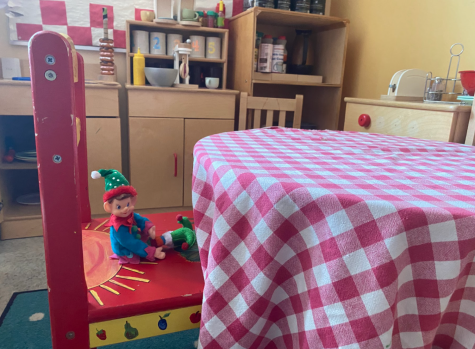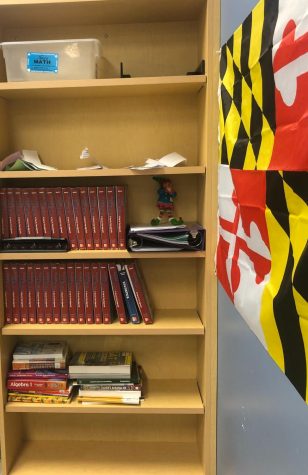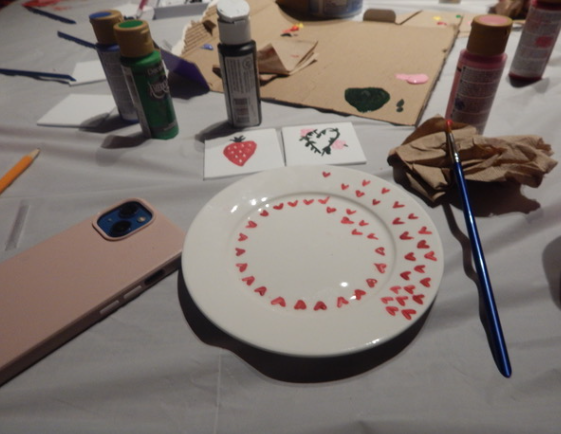Ceramics blends hands-on learning and mindfulness
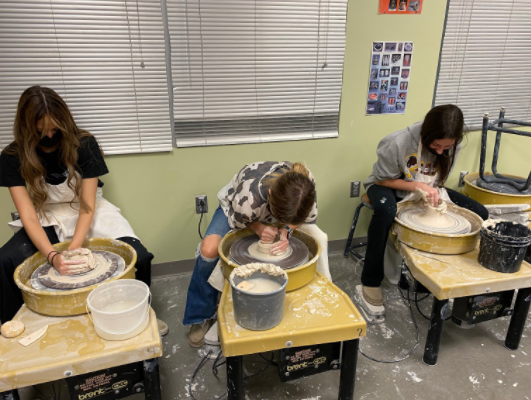
Ceramics 2 students work on their 6-8 inch taller than wide project.
A fresh block of clay just waiting to be cut, the smell of the kiln and the freshly fired pieces, the sound of the pottery wheels spinning, and all the creative possibilities, all in ceramics class.
The ceramics room is a peaceful room, the most peaceful in the school.
The tables have a big open area for students to work. The feeling of having a block of clay and a million ideas on what to do with it is a rush. From decoration to dishware, anything students create is satisfying to finish. So much time, effort, and creativity poured into a masterpiece.
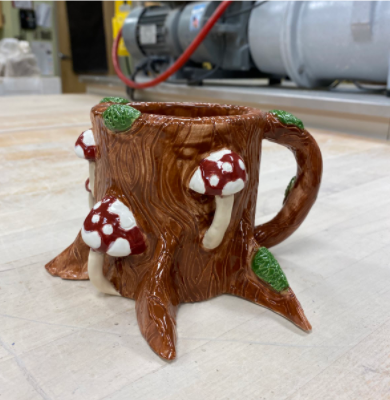
“It’s so satisfying taking time to create something and it actually turns out how you want it to. The fact that it’s also functional is even better. Not only does it look good, I can use it as well,” junior Timmy Stratsburger said.
Ceramics is an opportunity to have fun, encourage self discovery, and build important life skills.
Ashleigh Lutz, a graduate from Arizona State University, who helps teachers and students meet important goals and explore their passions gives her opinion on the importance of taking an elective like Ceramics, “When students make it into the workforce, it’s important to remember that certain skills simply cannot be taught. Employers cannot give employees creativity, drive, passion, or self-esteem. Those are things students have to discover within themselves, and elective courses help build such skills.”
When everyone is stressed out, ceramics class is important for students’ mental health.
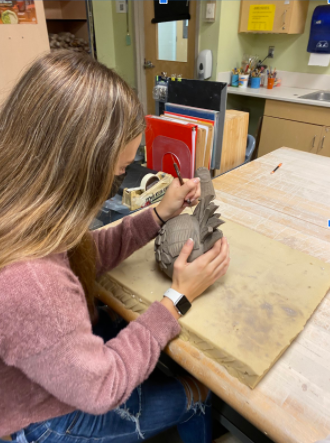
Senior Kelli Durbin took Ceramics 2 because she enjoyed taking Ceramics 1. During class her hands were busy, shaping the feathers on her chicken made of low fire clay. She used a pin tool and a silicone brush to smooth around the edges of the feathers. She used a technique called slip and score to place the feathers on the body of the chicken.
“I think it’s a good relaxing class. I can get in the zone when I work on my pieces and really focus on something that’s fun to do,” Kelli Durbin said.
Ceramics can have a variety of benefits that include learning to think more creatively, stress relief, and building self confidence through the satisfying process of creating artwork.
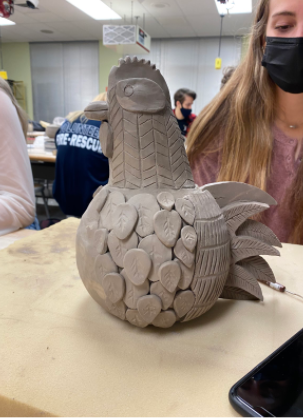
“Ceramics has helped me with my patience and craftsmanship. Working with clay can be a long tedious process,” Durbin said. “You have to keep the clay at the right dryness making sure it’s not too wet to work with. Adding details to my work is also time consuming. Nonetheless, time goes fast when you’re focused and having fun.”
There’s a lot to remember when working with clay. Specifically when working on the pottery wheel, you have to have soft enough clay to shape. The clay has to be wedged completely to rid of any air pockets there may be.
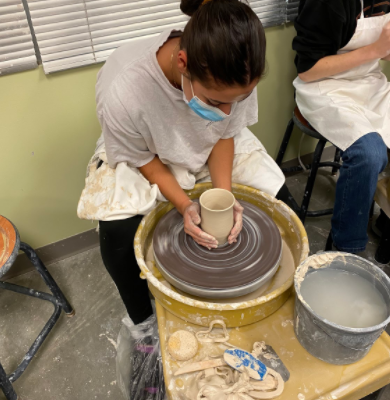
Throwing on the pottery wheel is a student favorite, class goes by in a flash when sitting down at the wheel.
First, cut about 2-3 pounds of clay of the clay block. the clay ball should be about the size of a fist. Then wedge the clay. Throw the clay from one hand to the other to ensure all air pockets are out of the clay. If there is an air pocket it can cause complications when raising the walls of the piece. The hardest part of throwing a piece is centering to most students in the class. Once its centered, begin by opening up the clay and make it into whatever shape or height you want.
This process is hard to learn and get used to but, Ceramics teachers, Mr. Madenspatcher and Mrs. Geisser, makes it easier.

Mrs. Geisser teaches Ceramics classes at FCC and taught ceramics here for many years. She gives insight on the difference between Ceramics class on a college level compared to a high school level, “College Ceramics classes meet for less hours a week, but students are expected to work anywhere from 4-8 hours during open studio time. Its more independent where students get an assignment but work a great deal on there own to complete it. In high school they get much more supervised help and input. And they meet for 80 minutes 5 days a week. If you are in a Ceramics major there will be many classes you take, Hand building, Wheel throwing, Glaze Application, and Mold making its more specialized.”
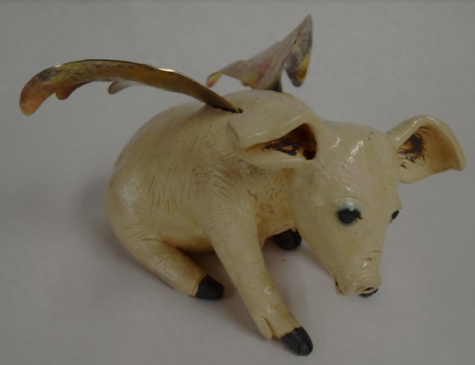
All of these techniques require the clay to be at a certain stage.
“Certainly time management is a definite skill learned. With Ceramics there are so many stages and you have to wait for the clay to dry , them for it to be fired, and then glaze and refire. Patience is definitely a skill one uses a great deal in Ceramics, Geisser says.
In both these pieces it allows Mrs. Geisser to combine her love of metal working and ceramics into sculptures.
Following your passion and having activities you like to do outside of work is refreshing.
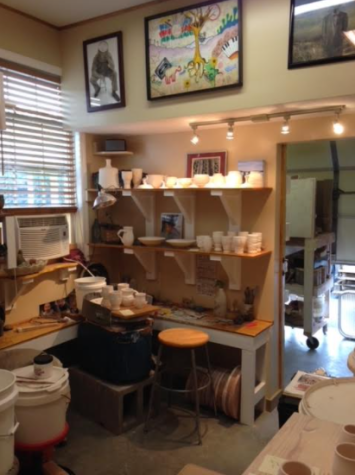
“I constructed my personal ceramics studio shortly after graduating from college, about the same time that i landed a job in the area of art education,” Mr. Madenspatcher said. “It was an important step in following through with my passion of working with clay and honestly was concerned that if i put it off, i may have never returned to the process that I truly enjoyed.”
Even though he worked in a career field he was passionate about, having that out of work hobby is still needed. Mr. Madenspatcher worked on pieces at his home studio to prepare for an art show his work was going to be showcased in.
He worked in his studio for 1-5 hours or even more in some instances. Even though its a lot of work its enjoyable an fun to him.
“I believe that many of the skills taught in ceramics may be applied outside of the classroom setting. Extremely important, just the hand and eye coordination that can be applied to almost anything, from a mechanic working on cars, to a florist arranging a display for a wedding, to a nurse or surgeon carefully addressing the needs of a patient. These are merely a few examples that one can consider with application to the outside real world, ” Mr. Madenspatcher said.
By taking Ceramics you would be doing yourself a favor and will learn important skills you need in the future or use in daily activities.
So give it a try and sign up for Ceramics!
Your donation will support the student journalists of Linganore High School. Your contribution will allow us to purchase camera/recording equipment and software. We hope to raise enough money to re-start a monthly printed issue of our paper.





